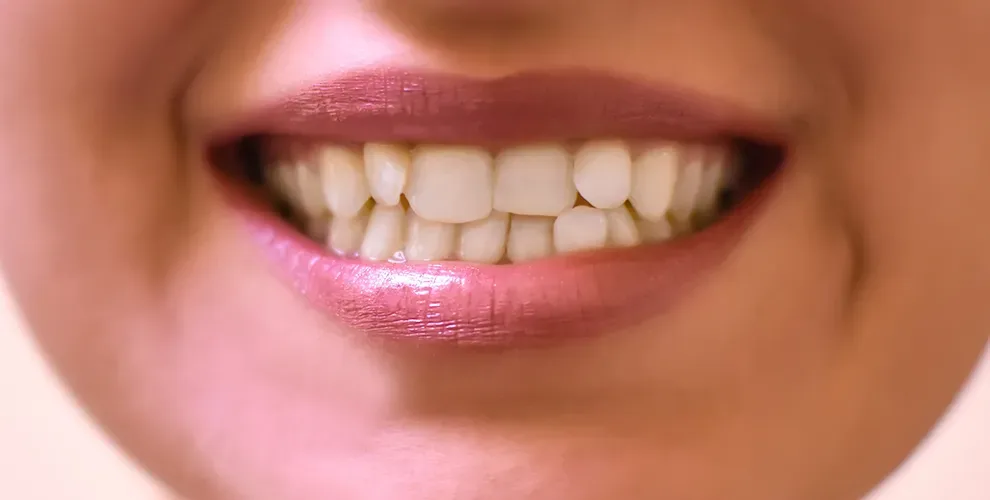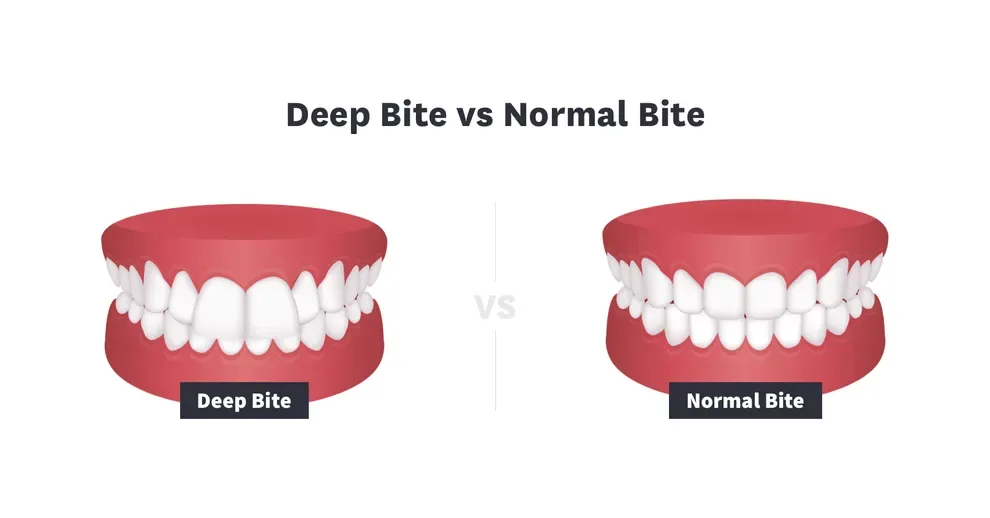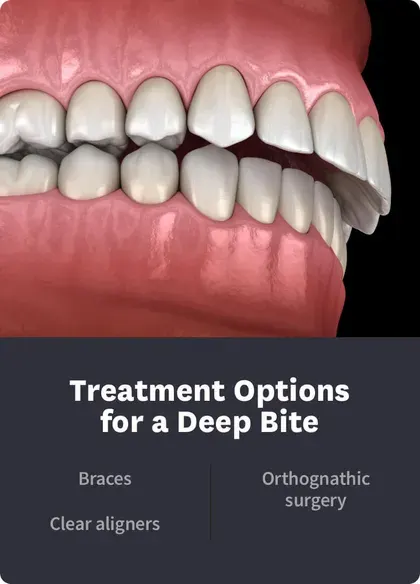What Does It Mean If You Have A Deep Bite? How To Fix It

Table of Contents
- Causes
- What is a Deep Bite?
- How Common is It?
- Common Deep Bite Symptoms
- Treatment Options
- What to Expect During Treatment
- Consequences of No Treatment
Deep bite is a common orthodontic condition in which the top row of teeth significantly overlaps the bottom row of teeth. Also known as an overbite or closed bite, deep bite may cause no symptoms if the condition is mild. In more severe cases, however, it can cause pain, headaches and even mouth injuries.
Dentists and orthodontists can treat most deep bites using braces or clear aligners. They may also use additional orthodontic devices like magnets and twin blocks to assist in the treatment process. Severe cases of deep bite may only be treatable using orthognathic surgery, a process which repositions the jaw to improve your bite and correct problems like deep bite.

What is a Deep Bite?
A deep bite (also called an overbite or a closed bite) is a type of malocclusion, or “bad bite.” It is diagnosed when the top row of teeth significantly overlaps the bottom row of teeth. This is because the person's top teeth are positioned too far forward compared to their bottom teeth.
While it is normal for the top row to rest a few millimeters over the bottom row, deep bites take this feature to the extreme. In a normal bite, one-third of the lower incisors is covered by the top incisors. People with a deep bite often have just half of their lower incisors showing when they bite down. In severe cases, you may not be able to see their lower teeth at all.
Causes of a Deep Bite
Deep bites can be caused by multiple biological factors, such as the following:
Your lower jaw should allow your bottom teeth to sit just behind your top teeth, but in extreme cases, a jaw that does not develop properly can cause a deep bite. This is because the jaw itself is too small for the top and bottom teeth to align.
Jaws can grow or become misaligned over time, shifting to the side or sliding backward. This might be related to genetics, or it could be caused by poor oral health later in life.
A lower jaw with tight, overdeveloped muscles can cause damage to the teeth and force the lower jaw to be pulled backward.
When teeth come in too far, it forces misalignment with the matching tooth, which can then lead to further misalignment problems that shove the jaw too far back.
Even if you do not have an underdeveloped lower jaw, having teeth removed or never come in can cause alignment issues similar to having a small jaw. Teeth will not fit together properly. To correct this bite issue, the muscles in your jaw will become tense and pull the jaw backward.
How Common is a Deep Bite?
Deep bite is a relatively common orthodontic condition. Studies estimate that 21.98% of all people worldwide have a deep bite. They also indicate that deep bite is equally common in all countries and populations.
Studies of orthodontic patients have shown that over 80% of deep bite cases are mild. These same studies also show that female patients are more likely to have a mild case of deep bite than male patients.
However, this may be because women are more likely to seek orthodontic treatment for a minor dental problem than men are. Further research is needed to confirm whether men are actually more likely to have moderate or severe deep bite than women are.
Deep bite is also one of the most common conditions that patients choose to address with orthodontic treatment as adults. If you are interested in treating your deep bite at an older age, you should know that you're not alone.
Common Deep Bite Symptoms
Aside from the obvious visual presentation, there are a few other signs of deep bite. Mild symptoms of a deep bite can include the following:
Mild chipping or wear-and-tear of the lower teeth
Crooked lower teeth
Mild mouth, jaw, or tooth pain
Occasional headaches
Significant signs of a deep bite include sores or ulcers on the roof of the mouth, significantly chipped teeth, lisping or other speech problems, and intense pain.

A deep bite that is not treated for a long time can also lead to increased tooth decay and gum disease. This is because patients’ crooked teeth are often difficult to clean, making them prone to plaque build-up. Since it is difficult to correct the position of crooked teeth without fixing a deep bite, these problems often occur alongside the condition.
Treatment Options
Deep bite does not always need to be treated. In fact, mild cases usually aren’t treated.
But patients who are experiencing pain, shifting teeth and other harmful symptoms should strongly consider treating their deep bite to relieve those symptoms. Some people also choose to treat their deep bite for cosmetic reasons.
Deep bite can be corrected using braces, clear aligners, orthognathic surgery or some combination of the above. Orthodontists may also use devices like elastics, magnets, mini-screws, twin blocks, and other tools to produce the desired results.
Braces or Aligners
Treating deep bite with braces or clear aligners typically costs between $3,000 and $5,000 in the US. However, this is just a rough estimate. The actual cost varies significantly depending on how complex your case is.
It’s a good idea to get a consultation appointment with the orthodontist you want to work with before you commit to treatment. This way, you can build a budget for this expense based on accurate numbers.
Orthognathic Surgery
If your deep bite is severe enough to require orthognathic surgery, the process will be considerably more involved. You will need to undergo a full course of orthodontic treatment before your surgery, then spend several weeks recovering from the surgery itself. In some cases, you may need to spend even more time in braces after your jaw heals.
Orthognathic surgery can be extremely expensive, often costing tens of thousands of dollars for the surgery alone. It is also usually considered a health insurance expense rather than a dental insurance one. This means that you may be able to get the procedure covered by insurance even if you don't have dental insurance.
Teeth Restoration
Finally, patients with severe wear on their anterior teeth as a result of their deep bite often wish to have those teeth restored as part of their treatment. This can be done with bonding, veneers, or crowns and will typically cost somewhere between $300 and $3,000 a tooth depending on the type of treatment you choose.
What to Expect During Deep Bite Treatment
Your treatment program will vary dramatically depending on the type of solution your doctor chooses. You should understand just what to expect before the program begins. However, this general set of steps can help you to prepare.
Braces: Step by Step
If you choose braces, your treatment plan might look like the following:
Your orthodontist takes molds of your teeth and makes models to show you what your bite will look like when it’s done.
Your orthodontist glues brackets on your teeth and connects them with wires.
Every few weeks, your orthodontist changes the wires.
Your brackets are removed, and retainers are installed.
Aligners: Step by Step
If you choose aligners, your treatment plan might look like the following:
Your dental professional takes molds of your teeth and makes models to show you what your bite will look like when it’s done.
Your professional makes a series of plastic trays that fit on your teeth to put them in the proper position.
You wear the trays per your doctor’s instructions, swapping them out every few weeks.
You wear a retainer tray at night when treatment is complete.
Surgery: Step by Step
If you choose surgery, your treatment plan might look like the following:
You meet with a surgeon and orthodontist and go through x-rays, CT scans, and other screenings to help guide the surgery.
You are placed under anesthesia, and your doctor reshapes your jaw.
You need several weeks to heal and allow the swelling to go down.
What Happens if You Don’t Treat a Deep Bite?
The American Association of Orthodontists lists several health problems that could take place in people who don’t fix a deep bite. They include the following:
Excessive wear of the lower teeth, which could lead to tooth loss
Painful sores or ulcers on the roof of the mouth
Crooked or crowded teeth
Taking care of a deep bite can help you avoid some of these serious problems and preserve your smile.
